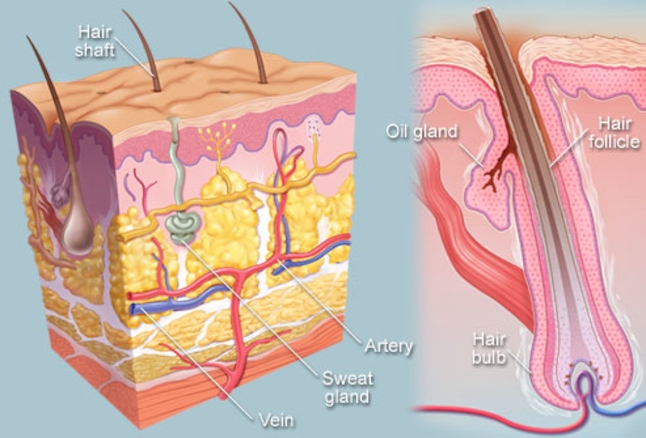Hair is a keratinous filament growing out of the epidermis. It is primarily made of columns of dead, keratinized cells. Strands of hair originate in an epidermal penetration of the dermis called the hair follicle.
Anatomy of hair can be further understood with the following terms:
Hair Shaft: Hair is the outer shaft of keratin material, the part that we all identify as hair conventionally.
Follicle: The root of the hair is called a follicle and is the part buried under the skin. It is the follicle that produces the hair shaft.
Follicular Unit: Hairs are not arranged singly in the scalp but are grouped in units consisting of one, two, three, four, or even more hair. A follicular unit is a collection of hair that are grouped in the skin.
Graft: A graft is a medical term that means tissue or organ taken from one part of the body and placed in another. A graft can be a skin graft, bone graft, cornea graft, kidney graft, etc. For hair transplant, a graft is the same as a follicular unit.

Hair has three layers:
At the hair follicle/hair bulb base, there is a dermal papilla, which contains the blood supply for the hair. The hair matrix, which contains the proliferating cells that generate the hair and the internal root sheath, is just above the dermal papilla and is separated from it by a basement membrane. Like the epidermis basal layer, the hair matrix cells proliferate and move upwards, gradually becoming keratinized to produce the hair.
A small bundle of smooth muscle cells called arrector pili muscle is associated with the hair follicle. This muscle’s contraction elevates the hair, forms goosebumps, releases heat, and helps sebum be released from the gland into the duct.
Hair color, like skin color, depends on the pigment melanin. However, there are alternative forms in hair: Pheomelanin (red or yellow) and Eumelanin (brown or black).
Melanocytes, the melanin-producing cells, are found in the hair matrix, and melanin is passed onto the matrix cells in the same way as it is passed to keratinocytes in the epidermis. As the progeny of melanin-containing matrix cells change into hard keratin, they keep their pigment.
Eventually, in old age, the melanocytes stop producing melanin, and hence hair turns white.
The production of hair is not continuous but cyclic. Hair Growth Cycle consists of three main stages:
Anagen Phase: In this phase, the hair starts growing from the follicle root. This phase lasts for 1,000 days, i.e., 2-5 years, and during this time, the matrix cells divide, become keratinized, and hair is produced. Hair grows approximately 10-15 cm per year. In general, the length of any human being’s hair is unlikely to grow more than one meter.
At any given point in time, approximately 85-90% of all hair is in the anagen phase.
Catagen Phase: This a transitional phase of regression that lasts 2-3 weeks on an average. The hair stops growing in this phase and detaches itself from the root and hence from the blood supply. The hair follicle shrinks to about 1/6th of the regular length. The lower part is destroyed, and the dermal papilla breaks away to enter into a resting phase.
At any given point in time, less than 5% of the hair is in the catagen phase.
During the Telogen phase, which lasts for several months, the cell division stops, hair growth ceases, and the hair’s attachment to the base of the follicle becomes progressively weaker. Finally, as a result of ordinary traction due to combing, washing, hair’s own weight, or a push by a new, growing hair, the old hair is eventually shed and discarded.
At any given point in time, approximately 10-15% of all hair follicles are in the telogen phase.